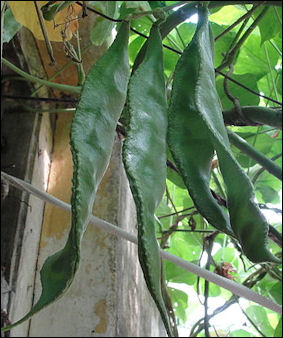DESERT AGRICULTURE
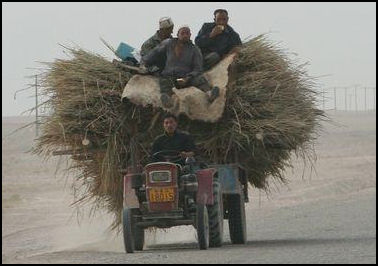 Desert soils are agriculturally productive if there is an ample water supply. They tend to be coarse in texture and rich in minerals. The richest soils are found in flood plains, alluvial fans, coastal plains and the seaward slopes of mountains. In the mountains terracing is necessary to keep the soil from being washed away in wet season. In many places the soil is too sandy, gravely, rocky to raise crops even if there is enough water.
Desert soils are agriculturally productive if there is an ample water supply. They tend to be coarse in texture and rich in minerals. The richest soils are found in flood plains, alluvial fans, coastal plains and the seaward slopes of mountains. In the mountains terracing is necessary to keep the soil from being washed away in wet season. In many places the soil is too sandy, gravely, rocky to raise crops even if there is enough water.
Economists think that desert countries should drop their ambitions of being self-sufficient in food and band together as block to bring food prices down.
Websites and Resources on Deserts: United States Geological Survey usgs.gov/gip/deserts ; Desert USA (good info on the world’s deserts); desertusa.com/life ; United Nations Global Desert Outlook unep.org/geo/gdoutlook ; Desert Biome article, University of California, Berkeley Desert Biome ; Blue Planet Biomes (about U.S. deserts) blueplanetbiomes.org ; Wikipedia article Wikipedia ;National Geographic online article National Geographic Oxfam Cool Planet oxfam.org.uk/coolplanet ; Sand Dunes article waynesword.palomar.edu ; United States Geological Survey usgs.gov/gip/deserts
Irrigation, Water and Agriculture

Assyrian irrigation watermill Agriculture accounts for 70 percent of all water use and irrigation grows 40 percent of the world’s food. In developing countries irrigation accounts for 80 percent of the water consumed. In places where irrigation doesn’t exist, if the rains fail, crops often fail.
Water for irrigation can come from wells, rivers, canals, lakes, ponds and reservoirs. Often dams are built to supply water for irrigation.
Pumps are important for irrigation. In the old days water wheels and manual labor were needed to lift water from wells, rivers, canals and ponds to agricultural land. Now gasoline- and diesel-powered pumps do much of the work. Pumps may be noisy but are a relatively cheap and efficient.
Studies in South Asia have shown that a traditional treadle water pump — operated by a person on a device that looks a bit like a Stairmaster stair climber — can increases the income of farmers by 25 percent. First introduced to Bangladesh in the 1980s and now widely used in Asia and sub-Sahara Africa, these pumps are easy to install and simple to operate and often deliver higher crops yields than those obtained using diesel pumps.
Irrigation Systems
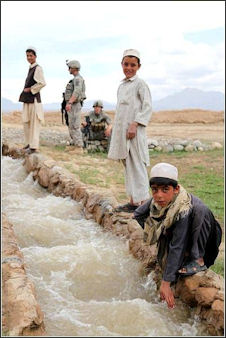
irrigation canal in Afghanistan Water used in irrigation often times originates from sources miles away and sometimes uses tunnels, aqueducts and canals that were built over a 1000 years ago. The water often flows from the source in a single canal which in turn divides into smaller canals that lead to the fields There may be thousands of fields, each averaging from a few acres to many dozen acres in size, or huge swaths of agricultural land.
The water flowing in and out is regulated by a complex process that has been fine tuned over the centuries. In many places water is distributed by opening and closing gates which provide water to certain area for a specific amount of time. Some places still use water clocks (a pot with a small hole in the bottom that measures out about three minutes) to determine when the gates of the irrigation system
The schedule for distributing water is made by an annual calendar. The various stages of growing process — the watering of the fields, the transplanting of sampling and the harvesting of the mature crop — are all determined by the calendar and sometimes each stage is marked by festivals and rites.
The distribution of water is often overseen by individuals who follow customs and rules to determine which fields get water when. In traditional societies the water is often distributed through a system based on fairness and equity in turn based on family size and land holdings. Each member of the community is entitled to their share as long as they fulfill their duties in maintaining the system. In corrupt system, water is often diverted to large landowners who produce cash crops which the government receives taxes or kickbacks.
Irrigation Canal Systems, see Morocco, Tunisia, Japan, Places and Facts
Problems with Irrigation

irrigation flow-gates in Kyrgyzstan Irrigation with canals is very inefficient. Lots of water is lost to evaporation, run offs and absorption into the soil before it reaches crops. Governments are often to blame for these practices because they subsidize water so heavily that farmers have little incentive to save it
Poorly-drained irrigated land leaves behind salt deposits as water evaporates. In many places, fields that once grew bountiful crops of grains are now encrusted in salt. More than a quarter of the world's irrigated land has become so salty that many crops will no longer grow there. To make the land productive again the fields have to be flooded four times to clear away the salt.
Irrigation also causes large amounts of salts, fertilizers and pesticides to be flushed into rivers and streams. Short supplies of water can result in increased in disease as untreated sewage water is used in irrigation.
The drilling of wells for irrigation, farming and animal herding can trigger an unhealthy cycle. Drilling wells causes the water table to drop. After a while the water may become too salty for crops and animals or too expensive to pump resulting in the sinking of more wells, which causes the water table to drop further.
Desert Irrigation

Efforts to replace spate irrigation with concrete dams often causes more harm than good because the flood deposits large amounts of sediment that clog the gates and canals.
Irrigation with canals is very inefficient. Lots of water is lost to evaporation, run offs and absorption into the soil.
Qanats and Karez Tunnels
Karez Tunnels underlie large areas of Turpan depression and are found througout Xinjiang in China . One of the ancient world’s great engineering feats, they are underground canals and boreholes used to carry water — from melted snow, springs and water tables under hills — from the highlands to farming areas. Some date back to the time of Alexander the Great.

Karez tunnel
Karez tunnels follow slopes down hill and are built underground so the water doesn't evaporate in the hot sun. From the sky they look like a long rows of gopher holes, giant anthills or donuts. These holes are outlets for vertical shafts that provide ventilation, and a means of excavating material. Dirt is piled around the entrances to prevent potentially-eroding rainwater from entering the system. Most of the holes are about 10 to 30 feet deep but some drop down almost 100 feet.
The karez system in Xinjiang ranks with the Great Wall of China and the Grand Canal in terms of time and labor spent building it and may exceed them as an engineering feat. The tunnels carry water, much of originally snow melt from the Tian Shen Mountains, to oases like Turpan. The combined length of all the karez canals in Xinjiang is around 1,900 miles, with about 60 percent of them still in use today.
Karez tunnels have largely been dug by hand from head wells on high ground near the source of the water to places where the water is used. It is believed millions of hours of forced labor was needed to build them. The long, downward slopping tunnels were dug using the vertical holes to reach the underground tunnel from the surface.
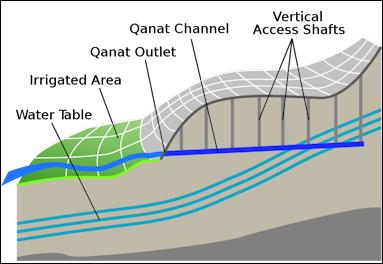
qanat
Karez technology was imported from Persia (Iran), where the wells are called qanats. The tunnels have traditionally been communally owned, with villagers splitting the cost of building and maintaining them. Holes used to dig the tunnels are used by laborers today to reach the underground canals, which from time to time have to be cleared of dirt and rubble.
Digging the tunnels and maintaining the karez system is hard and dangerous work. The men who do the digging, repairing and cleaning have traditionally been highly skilled and well paid. To repair the tunnels workers climb down the entry shaft to the tunnels. There they clean out the tunnels and stabilize weak sections with ceramic hoops. The work is often done by lantern light in extremely cramped conditions — most of the tunnels are barely large enough for a man to crawl through.
Desert Agriculture Innovations
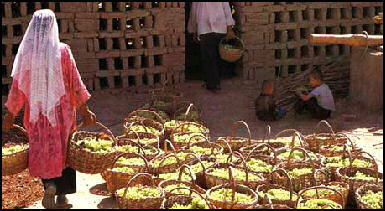
Raisin making Some have recommended that farms install more rain saving devices and reduce waste on irrigation by finding leaky pipes, replacing water ditches with pressurized taps, and using trickle-down agriculture that deliver small, steady amounts of water directly to the roots of plants.
Low-tech hydroponic schemes pioneered by Brazilian engineer Jose Roberto Fonseca include: 1) sprouting plants in water laced with nutrients held in plastic Coca-Cola bottles feed with ultra thin tubes; 2) using seawater desalinated with a solar-powered desalinator; 3) catching water from a well on a hillock and using gravity to deliver it to gardens below; 4) storing water in underground cisterns; 5) pumping water with solar-powered pumps; and 6) using recycling systems that avoid evaporation and reduces waste.
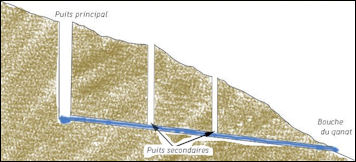
So-called resurrection plants — grassy plants such as “Xerophyra viscosa” found in the Drakenburg range in South Africa that can survive long periods without water and burst to life when it rains — are being mined for genetic material that can be inserted into corn and other crops that can help them grow in dry climates, with little or salty water and few fertilizer. “Xerophyra viscosa” is being studied because it can grow on rocks at high altitudes, in thin souls in a variety conditions and very little water.
To make the most of available water, scientists are experimenting with super absorbent polymers, or hyrdrogels, invented for disposable diapers. They are designed to help aid villagers with farms on sandy soils in arid climates retain water. The advance was initially ignored as too expensive for poor farmers in developing countries but now is generating some interest in richer, desert countries. Among the types being used are Stockabsorb produced by the German company Creasorb and TerraCottem, made by the Belgian company by the same name. TerraCottem sells for about $2 a kilogram, which makes it okay for landscaping but too expensive for agriculture.
Drip Irrigation and Water-Saving Technology
Environmentalists are pushing a more “crop by drop” approach to agriculture that stresses more efficient irrigation, planting more drought- and salt-tolerant plants that require less water and closely monitoring growing conditions such as soil humidity
Drip irrigation equipment delivers water to individual plants at times when the plant needs it so no water is wasted. Perfectly calibrated portions of nutrients and water to plant roots a drop at a time through holes in plastic hoses to individual plants. Ideally seeds should be planted just below the perforations in the hoses. Crops grown using drip irrigation include watermelons, apples, green onions, cucumbers, corn, hot peppers, melons, bell peppers, radishes, carrots, cabbage, soybeans, pears, tomatoes, squash and spinach.
Drip irrigation uses 30 to 90 percent less water than traditional methods. Under ideal circumstances, 800 gallons of water can be used on a large plot as opposed to 7,200 gallons with conventional irrigation and produce higher yields. Because the water source is so reliable the quality of the produce is good. The technology was developed in the 1960s in Israel but is only used on less than one percent of irrigated land.
An effort is also being made to harvest surface water that runs off fields and catchment area and reusing it on crops, collecting it in reservoirs for later use as drinking water and stopping pollution. If the water is polluted with pesticides and fertilizers the aim is to prevent it from entering rivers, lakes and the sea.
Oasis Agriculture
Dates are the traditionally food of desert oases. Olives, figs, peaches, melons, grapes, citrus fruits, fruit, vegetables, beans, rice, barely, wheat, cotton, sugar cane, alfalfa, apricots, peaches, pomegranates, and other food grains can all be raised around an oasis if there is enough water and in some cases shade.
Oasis water is directed into feeder channels that distribute water throughout an elaborate grid network. Every piece of land is granted so many hours of water according to its size. When each man has his share, his feeder is closed off with a big stone and another one is opened for someone else. The distribution is supervised by a "water bailiff" who is paid in crops from the irrigated fields.
Buying and Renting Agricultural Land Abroad
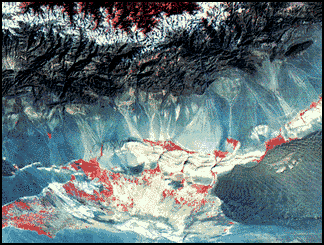
Some countries with large tracts of desert and limited agricultural land are increasingly looking into buying or renting land in other countries to use for agriculture. Saudi Arabia has held discussion with Thailand, Indonesia , Kazakhstan and South Africa about using some of their land. The United Arab Emirates has talked to Egypt, Sudan and Yemen is pursuing a $3 billion deal with Pakistan. South Korea has negotiated with Russia and Sudan about land and China is reportedly seeking deals with the Philippines, Australia and Africa. The terms of the deal vary. In some cases the land is bought outright. In other cases it is leased in return for development money. Many of the deals have stipulations to hire local workers and rules on where the food goes after harvests.
The idea is not new. The Romans did it. European nations practiced it on a large scale in the colonial era to produce profitable cash crops. Some are alarmed that “mother country” and neo-colonial arrangements could emerge again. Others are worried about greedy governments selling and renting land used by villagers to feed their families. In any case, as population grows, especially if global warming marginalizes agriculture areas, there will be additional pressures to consider such strategies.
Creating Desert Wetlands
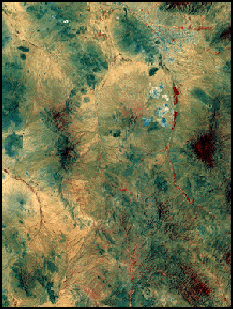
Carl Hodges, a environmental scientist at the University of Arizona and friend of the actor Martin Sheen and the late Marlon Brando, is major proponent of utilizing sea water to make the desert bloom, provide energy and combat global warming.
Hodges has proposed setting up massive artificial seawater farms in which seawater is delivered to coastal deserts by canals. Under the scheme sea water first flows into shrimp farms and then, loaded with nutrients, it is directed from the farms to wetlands with mangrove forests and salicornia — a plant that grows well in salt water and can provide food or material for biofuels. One of the advantages of the plan is that it doesn’t eat up valuable agricultural land needed to grow crops. Water is naturally filtered as it returns to sea. Heavy seawater also helps raise the freshwater table.
The system also helps combat global warming by providing carbon-dioxide-sucking plants and canals that can drain water from the oceans as sea levels rise. Hodges has concluded that 50 such seawater farms — capable of diverting the equivalent of three Mississippi Rivers — would be enough to absorb the sea level rises generated by global warming. A seawater farm that follows this plan is planned for the Kino Bay area in the Sonora Desert in Mexico west of Baja California. One was built in Eritrea in 1999, achieving several of its goals, before it was undermined by wars between Eritrea and Ethiopia.
Growing Mangroves in the Desert
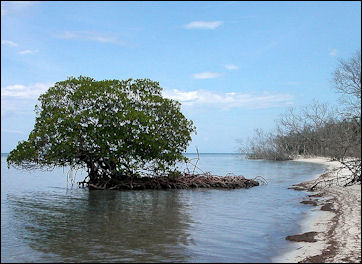
mangroves Also involved in this kind of project has been Gordon Sato, a cell biologist and cancer-drug pioneer who developed a breakthrough cancer drug in the early 1980s and since then has devoted himself to reducing poverty and making the desert bloom using mangroves. The thrust of his scheme is growing mangroves in salt water and feeding the foliage to sheep and goats (camels were known to eat the leaves) and provide food and a means for making a living to thousands.
Sato began his project by planting thousands of mangroves along the Eritrean coast of the Red Sea. All the saplings died. Sato then a closer look around and noticed that mangroves were growing naturally where freshwater was diverted during brief seasonal rains. He then determined that the mangroves grew there not because of freshwater but because the freshwater supplied minerals — namely nitrogen, phosphorus and iron — that the seedlings needed but sea water lacked in sufficient amounts. Sato then developed a low-tech means of delivering these minerals: each seedling was planted with a small piece of iron and a small plastic bag, with holes punched in it, containing a fertilizer rich in phosphorus and nitrogen.
The saplings were planted using this method in 2001. As of 2007, 700,000 mangroves were growing on a formally treeless shore of Hirgigo, a few miles down the shore from the Eritrean port Massawa. Sato named the project Manzanar, after the World War II internment camp in California desert where thousands of Japanese-Americans were interred, and coaxed crops from barren soil. Describing the site in 2007 Kennedy Ware wrote in National Geographic, “Many of the mangrove trees are now well above head height, and the yellow-green coats of ripe propagule are beginning to split open, showing the plump green leaves within. The mangrove mud is sprouting pneumatophores, as if someone had planted crop of pencils. Barnacles and oysters have started to settle on them, and crab and winkle trails crisscross the sediment.”
Since the planting began fisherman have begun catching small fish such as mullet that they didn’t catch before as well as bigger predators that feed on mullet. In villages nearby sheep feed on mangrove propagules and leaves, which are nutritious but don’t provide all the nutrients animals need so a small amount of fish meal is necessary to make up the difference.
Image Sources: Wikimedia Commons and 1) 5) 6) USGS 2) University of Washington 3) Perechon
Text Sources: "Deserts Geology and Resources" by A.S. Walkers, USGS Online publication; Rick Gore, National Geographic, November 1979 [┵]; New York Times, Washington Post, Los Angeles Times, Daily Yomiuri, Times of London, National Geographic, The New Yorker, Time, Newsweek, Reuters, AP, Lonely Planet Guides, Compton’s Encyclopedia and various books and other publications.
Last updated March 2011

